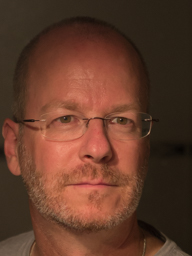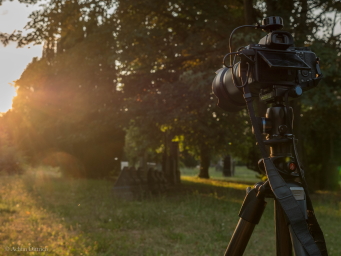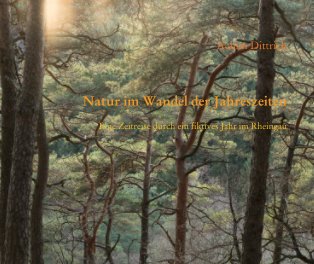
Als Kind haben mich zwei Landschaften besonders geprägt: Die holländische Nordseeküste mit ihrem rauhen Charme und ein kleiner Weiher in den Dolomiten Südtirols. Ständig gab es etwas zu entdecken, und die Zeit verging viel zu schnell, aber die Erinnerung daran und was diese Zeit so besonders gemacht hat sind geblieben.
Später waren es dann die Rucksacktouren in Lappland und den Rocky Mountains und Touren am Amazonas und im Pantanal in Brasilien, die mich tief beeindruckt haben. Der Blick über das Urstromtal des Rapaädno im Sarek-Nationalpark mit seinen Mäandern, Sandbänken, Altarmen und Sumpfgebieten beispielsweise hat mich seitdem nicht mehr losgelassen.
In jüngerer Zeit kamen dann Island und Grönland hinzu, die stark von den Elementen geprägt sind und späktakuläre und magische Naturlandschaften zu bieten haben.
Da ich aus familiären Gründen in etwa die Hälfte meiner Zeit in Griechenland verbringe, habe ich die Naturschätze dort mehr und mehr kennen gelernt. Hier gibt es noch viel zum Teil noch sehr ursprüngliche Natur zu entdecken.
An einem frühen Sommermorgen draußen in der Natur zu sein ist für mich Ausgleich vom Alltag, aber vor allem genieße ich die Atmosphäre mit den Tierstimmen, den Gerüchen, den Farben und der Luft.
Ich könnte nicht mehr darauf verzichten.

As a child I have been influenced by two landscapes in particular: the Dutch north sea coast with its rough charm and a little pond in the Dolomites of South Tyrol. There was always something to be discovered and the time passed away just too quickly but the memories of those times and what made it so special has remained.
Later, it was the tracking tours in Lapland and in the Rocky Mountains and trips on the Amazon and in the Pantanal wetland in Brazil which impressed me deeply. The view over the original valley of the Rapaädno in the Sarek national park with its meanders, sandbanks, oxbow lakes and swamp areas for example has never let go of me ever since.
More recently, Iceland and Greenland have been added, which are strongly influenced by the elements and have spectacular and magical natural landscapes to offer.
Since I spend about half of my time in Greece for family reasons, I have that Natural treasures got to know there more and more. There is still a lot of nature to discover here, some of which is still very pristine.
To be out in nature on an early summer day is a compensation for the everyday life but most of all I enjoy the atmosphere with the animal voices, the smells, the colours, the air.
I just could not do without it anymore.
Ich habe 1986 mit dem Fotografieren angefangen, inspiriert von den Bildern, die auf meiner ersten Rucksacktour in Lappland entstanden sind. Bis Mitte der 90er Jahre habe ich intensiv fotografiert, bevor der Beruf in den Vordergrund trat.
2011 habe ich dann wieder angefangen, diesmal natürlich mit einer digitalen Ausrüstung, und sehr schnell hat sich daraus aufs Neue eine Leidenschaft entwickelt, die für mich immer wichtiger geworden ist und der ich dementsprechend mehr Zeit widme denn je zuvor.
Stand anfangs noch die Tierfotografie im Vordergrund, so habe ich mit der Zeit immer mehr Gefallen am Einfangen von Landschaften und insbesondere von Stimmungen gefunden. Aber wie so oft ist es dann das Unerwartete, das einem neue Perspektiven eröffnet und so war es ein Ausflug in das Gallikos - Delta westlich von Thessaloniki im Norden Griechenlands, das mir die Faszination einer vielfältigen und bis dato unbekannten Tierwelt beschert hat. Und so widme ich mich nun beidem - dem Einfangen mystischer Stimmungen und der Tierfotografie.
Ich wohne im Rheingau, einer vom Weinbau geprägten Kulturlandschaft, verbringe aber, wie oben bereits erwähnt, aus familiären Gründen viel Zeit in Griechenland.
In Deutschland ist es eine besondere Herausforderung, in einer Landschaft, in der praktisch kein Flecken mehr vom Menschen unbeeinflusst ist, gute Aufnahmen zu machen. Umso schöner, wenn es trotzdem gelingt. In Griechenland gibt es zwar noch wilde, unberührte Natur, aber überall dort, wo Menschen anzutreffen sind, sorgt der überaus achtlose Umgang mit Plastikmüll dafür, dass mir oft die Lust am Fotografieren vergeht. Es ist eine Schande wie der Mensch allzu oft mit der Natur umgeht.
Seit Ende 2017 arbeite ich nebenberuflich als freier Fotograf und habe mir damit einen Traum erfüllt.
With photography I started in 1986, inspired by the photos which arose from my first tracking tour in Lapland. I pursued this passion until the mid 90s until the job came more to the fore.
I started again in 2011 this time of course with a digital equipment. Soon again it became a passion that has become more and more important to me and so I devote more time to it than ever before.
At the beginning animal photography was my focus but over time I more and more enjoyed the capturing of landscapes and special moods. But as so often the unexpected opens up new perspectives and so it was a trip to the Gallikos delta west of Thessaloniki in northern Greece, which has given me the fascination of a diverse and previously unknown wildlife. And so I now dedicate myself to both - capturing mystical moods and wildlife photography.
I live in the Rheingau, a cultural landscape shaped by viticulture but, as mentioned already in the section above, I spend a lot of time also in Greece due to familiy obligations.
n Germany it is a special challenge to take good photos in a landscape where barely no spot remained unaffected by human influence. All the nicer then when it works out even though. In Greece however, there is still wild, untouched nature but whereever poeple can be found, the extremely careless handling of plastic waste means that I often lose the desire to take pictures. It is a shame how humens treat nature just too often.
Since end of 2017 I also work as a part time freelance photographer and have thereby fulfilled me a dream.
Im tagtäglichen Leben haben die meisten Menschen in Deutschland und anderswo in der sogenannten entwickelten Welt nur noch wenig Kontakt zur Natur. Die meiste Zeit sind wir von Beton, Stahl und Glas umgeben, und durch den beständig wachsenden Druck der Arbeitswelt gibt es immer weniger Zeit und Muße, um sie mit und in der Natur zu verbringen, selbst wenn das Bedürfnis danach bestehen würde.
Die unberührte Natur ist weltweit auf dem Rückzug. In Deutschland gibt es sie praktisch nicht mehr. Im Dienste des Fortschritts und der Steigerung des Wohlstands wird alles genutzt: Die Flächen an Land für die Land- und Forstwirtschaft, für Städte und Verkehrsinfrastruktur, die zu Wasser als Wasserstraßen oder für Freizeit und Wassersport.
Der Rheingau, mein heimisches Fotorevier
, ist lange schon Teil des
Rheingau-Taunus-Kreises, aber seine Bewohner identifizieren sich seit jeher stark mit diesem
Landstrich, der im Süden an den Rhein grenzt.
Die Landschaft wird vom Weinbau und den Wäldern des Taunushangs geprägt und seit vielen Jahrhunderten schon land- und forstwirtschaftlich genutzt. Mit zunehmender Intensivierung der Nutzung sind heute auch hier nur noch kümmerliche Reste der ursprünglichen Natur vorhanden. Die heute geschützten Auwaldflächen entlang des Rheins zwischen Rüdesheim und Winkel lassen erahnen, welcher urwüchsige Lebensraum hier einmal bestanden hat. Aber nur wer beispielsweise in Lappland, Kanada oder Alaska Urstromtäler kennengelernt hat, versteht, was hier verloren gegangen ist.
Auch die fortschreitende Landflucht trägt dazu bei, dass das sowieso schon geringe Verständnis
der Natur und ihrer Zusammenhänge noch weiter sinkt. So wird beispielsweise auch nach langen
Trockenperioden im Sommer etwa ein weiterer regenloser Sonnentag bei der Wettervorhersage im
Radio oder Fernsehen regelmäßig als schönes Wetter
angekündigt. Es ließen sich unzählige
weitere Beispiele aufführen.
Wir sind Teil der Natur und betreiben doch Raubbau an ihr. Das Verständnis, dass es langfristig kein Überleben geben wird, wenn wir unser Leben nicht in Einklang mit der Natur bringen, steigt langsam, auch wenn ein Gegensteuern nicht zu erkennen ist. Der kürzlich verstorbene Physiker Stephen Hawking hat der Menschheit Ende 2016 in einem Vortrag an der Oxford Union Debate Society noch 1000 Jahre auf unserem Planeten eingeräumt. Es besteht zu befürchten, dass diese Schätzung zu optimistisch ist ...
Und so soll dieser Webauftritt neben Fotos von anderen Ländern und Landschaften einige der noch verbliebenen Schönheiten unserer Region zeigen.
In their day-to-day lives, most people in Germany and elsewhere in the so called developed world have only little contact with nature. Most of the time we are surrounded by concrete, steel, glass and asphalt. Due to the ever increasing pressure in the work environments there is less and less time and leisure which could be spent in nature ever if the desire for it was there.
Unspoiled, original nature is on the retreat worldwide. In Germany it practically does not exist anymore. In the name of progress and for the increase of prosperity everything gets used: the areas on land for forestry and agriculture, for cities and transport infrastructure, those by sea for waterways and for leisure and water sports.
The Rheingau, about 50 km west of Frankfurt, as my domestic photography territory is part of the Rheingau – Taunus district for a long time now but the local population has always identified itself strongly with this strip of land which borders the river Rhine in the south.
The landscape has been shaped by viticulture and by the forests of the Taunus hillside and has been utilized in agricultural and silvicultural ways for many centuries now. With the increasingly intensified utilization only miserable reminders of the original nature have remained. The currently protected alluvial forest along the river front between Rüdesheim and Winkel gives a hint of what natural habitat once existed. But only those who have experienced original rivers in Lapland, Canada or Alaska understand what has been lost here.
The progressive rural exodus also contributes to the further decrease of the already little understanding of nature and its interrelations. Even after long dry periods in the summer for instance the weather forecasts in the radio or on television tend to announce another rainless solar day as „nice weather“. Countless further examples could be listed.
We are part of nature but overexploit it even though. The understanding that there will not be survival should we not manage to bring our ways of living in line with nature rises slowly. An active counter-steering however is not apparent. In a lecture at the Oxford Union Debate Society the world-famous physicist Stephen Hawking recently granted mankind only another 1000 years on our planet. There is reason to fear that this estimate is too optimistic ...
And so this Web site shall show some of the remaining beauties of our region as well as photos of other countries and landscapes.
Was Kamera und Objektive angeht, so habe ich bis 2020 zwei verschiedene Ausrüstungen verwendet: hochauflösende spiegellose Vollformatkameras mit den zugehörigen Objektiven für Landschaftsaufnahmen und ebenfalls spiegellose Kameras mit kleinerem Sensor für Tier- und Makroaufnahmen.
Seit 2021 bin ich aber dazu übergegangen, die Vollformatkameras mit den entsprechenden Objektiven auch für die Tier- und Macroaufnahmen zu verwenden, da die Vorteile der besseren Bildqualität bzgl. Farbwiedergabe, Dynamikumfang und Auflösung die Nachteile des höheren Gewichts bei weitem überragen.
Generell ist die Qualität von Kamera und Objektiv wichtig, wobei die eines qualitativ hochwertigen Objektivs vielfach unterschätzt wird. Nicht nur die Schärfe und das Bokeh, sondern auch die Farbwiedergabe wird entscheidend durch das Objektiv mitbestimmt.
Aber ohne das spezielle Motiv, die Komposition, die Stimmung hilft auch die beste Ausrüstung nicht ...

Landschaftsaufnahmen
Sony α7R IV und α7R II
ZEISS Batis 2/25
Sony FE 16 - 35 mm F2,8 GM
Sony ZEISS Distagon T* FE 35 mm F1,4 ZA
Sony ZEISS Planar T* FE 50 mm F1,4 ZA
Sony ZEISS Sonnar® T* FE 55 mm F1,8 ZA
ZEISS Batis 1.8/85
Sony FE 70–200 mm F2,8 GM OSS
Sony RMT-VP1K Fernbedienung und IR-Empfänger
Tier- und Makroaufnahmen
Panasonic Lumix G9 und GH3 sowie Sony α7R IV und α7R II
Olympus M.ZUIKO DIGITAL ED 300mm 1:4.0 IS PRO
Olympus M.ZUIKO DIGITAL ED 12‑40mm F2.8 PRO
Olympus M.ZUIKO DIGITAL 1.4x Telekonverter MC‑14
Olympus M.ZUIKO DIGITAL ED 60mm 1:2.8 MACRO
Sony FE 600mm F4,0 GM OSS
Sony FE 200-600mm F5,6-6,3 G OSS
Sony SEL 14x Telekonverter
Sonstige Ausrüstung
Stativ Manfrotto 055CXPRO3
Kugelkopf Sirui K-10X
Graukarte für manuellen Weißabgleich
Rucksack MindShift Rotation 180 Professional
Rucksack MindShift BackLight 26l
Rucksack Vanguard Alta Rise 45
Lowepro Lens Trekker 600 AW III
Lee Filter
Darktable 3.4.1 - 4.0.1
Monitor Eizo CG2730 ColorEdge
As far as camera and lenses are concerned, I have used two different types of equipment until 2020: high-resolution mirrorless full-frame cameras with the associated lenses for landscape photography and also mirrorless cameras with a smaller sensor for animal and macro photography.
Since 2021, however, I have switched to using the full-frame cameras with the corresponding lenses also for animal and macro shots, as the advantages of a better image quality in terms of color rendering, dynamic range and resolution by far outweigh the disadvantages of the higher weight.
In general, the quality of the camera and lens is important, whereby the quality of a high-quality lens is often underestimated. Not only the sharpness and the bokeh but also the color rendering is decisively influenced by the lens.
But without the special motive, the composition, the mood even the best equipment will not help ...

Landscape Photography
Sony α7R IV and α7R II
ZEISS Batis 2/25
Sony FE 16 - 35 mm F2,8 GM
Sony ZEISS Distagon T* FE 35 mm F1,4 ZA
Sony ZEISS Planar T* FE 50 mm F1,4 ZA
Sony ZEISS Sonnar® T* FE 55 mm F1,8 ZA
ZEISS Batis 1.8/85
Sony FE 70–200 mm F2,8 GM OSS
Sony RMT-VP1K Remote Control and IR Receiver
Wildlife- and Macro Photography
Panasonic Lumix G9 and GH3 and Sony α7R IV and α7R II
Olympus M.ZUIKO DIGITAL ED 300mm 1:4.0 IS PRO
Olympus M.ZUIKO DIGITAL ED 12‑40mm F2.8 PRO
Olympus M.ZUIKO DIGITAL 1.4x Teleconverter MC‑14
Olympus M.ZUIKO DIGITAL ED 60mm 1:2.8 MACRO
Sony FE 600mm F4,0 GM OSS
Sony FE 200-600mm F5,6-6,3 G OSS
Sony SEL 14x Teleconverter
Other Equipment
Stativ Manfrotto 055CXPRO3
Kugelkopf Sirui K-10X
Graukarte für manuellen Weißabgleich
Rucksack MindShift Rotation 180 Professional
Rucksack MindShift BackLight 26l
Rucksack Vanguard Alta Rise 45
Lowepro Lens Trekker 600 AW III
Lee Filter
Darktable 3.4.1 - 4.0.1
Monitor Eizo CG2730 ColorEdge

Natur im Wandel der Jahreszeiten
Eine Zeitreise durch ein fiktives Jahr im Rheingau
Das Buch stellt den jahreszeitlichen Kreislauf im Leben von Pflanzen und Tieren im Rheingau und damit stellvertretend für unsere Mittelgebirge anhand ausgewählter Bilder dar, beginnend mit dem Übergang vom Winter zum Frühling.

Natur im Wandel der Jahreszeiten
A journey through a ficticious year in the Rheingau
The book represents the seasonal cycle in the life of plants and animals in the Rheingau and thus representative of our low mountain ranges on the basis of selected images, starting with the transition from winter to spring.

A Glimpse of Nature: from Greenland to Greece
Einzelausstellung in der Govedarou Art Gallerie in Thessaloniki, Griechenland vom 26.2. - 14.3.2020
Zum Anschauen des E - Katalogs auf issuu hier klicken


A Glimpse of Nature: from Greenland to Greece
Solo photography exhibition in the Govedarou Art Gallery in Thessaloniki, Greece from the 26th Feb. - 14th Mar. 2020
To view the eBook on issuu click here

Kontakt
Dr. Achim Dittrich
Rheingauer Straße 49
65343 Eltville
Telefon: +49 (0) 15124186981
E-Mail: achim_dittrich@web.de
Verantwortlich für den Inhalt
gemäß § 55 Abs. 2 RStV
Dr. Achim Dittrich
Rheingauer Straße 49
65343 Eltville
Diensteanbieter
gemäß § 5 TMG
Dr. Achim Dittrich
Rheingauer Straße 49
65343 Eltville
Steuernummer: 037 812 30594
Webseite
(handgemacht)
Layout: Dr. Achim Dittrich
Programmierung: Jens Schroeder (Version 2.0 - 3.2)
Dr. Achim Dittrich (1.0 / ab 3.3)
Version: 3.5.1
Contact
Dr. Achim Dittrich
Rheingauer Straße 49
65343 Eltville
Telephone: +49 (0) 15124186981
E-Mail: achim_dittrich@web.de
Responsible for contents
according to Sec. 55, para. 2
German Federal Broadcasting
Agreement (RstV)
Dr. Achim Dittrich
Rheingauer Straße 49
65343 Eltville
Information provided
according to Sec. 5
German Telemedia Act (TMG)
Dr. Achim Dittrich
Rheingauer Straße 49
65343 Eltville
Tax No.: 037 812 30594
Website
(handmade)
Layout: Dr. Achim Dittrich
Development: Jens Schroeder (Version 2.0 - 3.2)
Dr. Achim Dittrich (Verion 1.0 / 3.3 onwards)
Version: 3.5.1
Haftung für Inhalte
Als Diensteanbieter sind wir gemäß § 7 Abs.1 TMG für eigene Inhalte auf diesen Seiten nach den allgemeinen Gesetzen verantwortlich. Nach §§ 8 bis 10 TMG sind wir als Diensteanbieter jedoch nicht verpflichtet, übermittelte oder gespeicherte fremde Informationen zu überwachen oder nach Umständen zu forschen, die auf eine rechtswidrige Tätigkeit hinweisen.
Verpflichtungen zur Entfernung oder Sperrung der Nutzung von Informationen nach den allgemeinen Gesetzen bleiben hiervon unberührt. Eine diesbezügliche Haftung ist jedoch erst ab dem Zeitpunkt der Kenntnis einer konkreten Rechtsverletzung möglich. Bei Bekanntwerden von entsprechenden Rechtsverletzungen werden wir diese Inhalte umgehend entfernen.
Urheberrecht
Die durch die Seitenbetreiber erstellten Inhalte und Werke auf diesen Seiten unterliegen dem deutschen Urheberrecht. Jegliches urheberrechtlich geschützte Material auf dieser Webseite (Bilder, Texte, Grafiken etc.) darf ohne vorherige ausdrückliche Zustimmung des Urhebers weder ganz noch teilweise kopiert, verändert, vervielfältigt, veröffentlicht oder öffentlich zugänglich gemacht werden.
Soweit die Inhalte auf dieser Seite nicht vom Betreiber erstellt wurden, werden die Urheberrechte Dritter beachtet. Insbesondere werden Inhalte Dritter als solche gekennzeichnet. Sollten Sie trotzdem auf eine Urheberrechtsverletzung aufmerksam werden, bitten wir um einen entsprechenden Hinweis. Bei Bekanntwerden von Rechtsverletzungen werden wir derartige Inhalte umgehend entfernen.
Liability for Contents
As service providers, we are liable for own contents of these websites according to Sec. 7, paragraph 1 German Telemedia Act (TMG). However, according to Sec. 8 to 10 German Telemedia Act (TMG), service providers are not obligated to permanently monitor submitted or stored information or to search for evidences that indicate illegal activities.
Legal obligations to removing information or to blocking the use of information remain unchallenged. In this case, liability is only possible at the time of knowledge about a specific violation of law. Illegal contents will be removed immediately at the time we get knowledge of them.
Copyright
Contents and compilations published on these websites by the providers are subject to German copyright laws. Any copyrighted material on this website (images, texts, graphics, etc.) may not be copied, altered, reproduced, published or made public, either in part or in full, without the prior consent of the author.
Copyright laws of third parties are respected as long as the contents on these websites do not originate from the provider. Contributions of third parties on this site are indicated as such. However, if you notice any violations of copyright law, please inform us. Such contents will be removed immediately.
